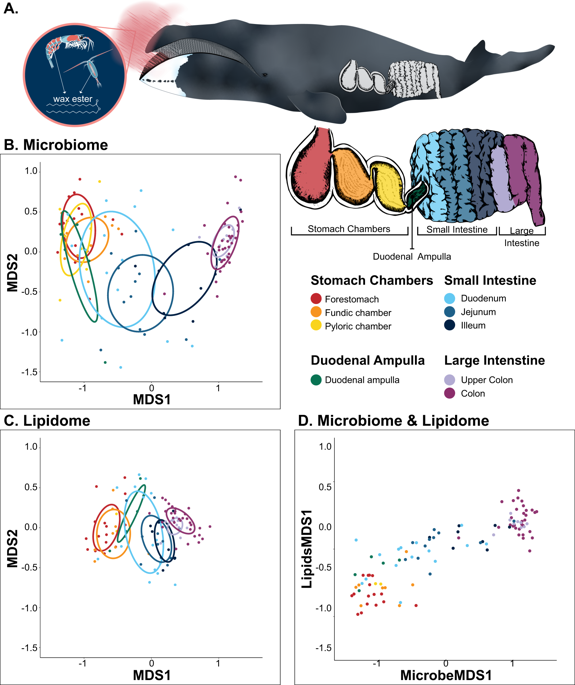Our official English website, www.x-mol.net, welcomes your
feedback! (Note: you will need to create a separate account there.)
Coordinated transformation of the gut microbiome and lipidome of bowhead whales provides novel insights into digestion.
The ISME Journal ( IF 10.8 ) Pub Date : 2019-12-02 , DOI: 10.1038/s41396-019-0549-y Carolyn A Miller 1 , Henry C Holm 1 , Lara Horstmann 2 , John C George 3 , Helen F Fredricks 1 , Benjamin A S Van Mooy 1 , Amy Apprill 1
The ISME Journal ( IF 10.8 ) Pub Date : 2019-12-02 , DOI: 10.1038/s41396-019-0549-y Carolyn A Miller 1 , Henry C Holm 1 , Lara Horstmann 2 , John C George 3 , Helen F Fredricks 1 , Benjamin A S Van Mooy 1 , Amy Apprill 1
Affiliation

|
Whale digestion plays an integral role in many ocean ecosystems. By digesting enormous quantities of lipid-rich prey, whales support their energy intensive lifestyle, but also excrete nutrients important to ocean biogeochemical cycles. Nevertheless, whale digestion is poorly understood. Gastrointestinal microorganisms play a significant role in vertebrate digestion, but few studies have examined them in whales. To investigate digestion of lipids, and the potential contribution of microbes to lipid digestion in whales, we characterized lipid composition (lipidomes) and bacterial communities (microbiotas) in 126 digesta samples collected throughout the gastrointestinal tracts of 38 bowhead whales (Balaena mysticetus) harvested by Alaskan Eskimos. Lipidomes and microbiotas were strongly correlated throughout the gastrointestinal tract. Lipidomes and microbiotas were most variable in the small intestine and most similar in the large intestine, where microbiota richness was greatest. Our results suggest digestion of wax esters, the primary lipids in B. mysticetus prey representing more than 80% of total dietary lipids, occurred in the mid- to distal small intestine and was correlated with specific microorganisms. Because wax esters are difficult to digest by other marine vertebrates and constitute a large reservoir of carbon in the ocean, our results further elucidate the essential roles that whales and their gastrointestinal microbiotas play in the biogeochemical cycling of carbon and nutrients in high-latitude seas.
中文翻译:

弓头鲸肠道微生物组和脂质组的协调转化为消化提供了新的见解。
鲸鱼消化在许多海洋生态系统中发挥着不可或缺的作用。通过消化大量富含脂质的猎物,鲸鱼支持了它们的能量密集型生活方式,同时也排泄出对海洋生物地球化学循环很重要的营养物质。然而,人们对鲸鱼的消化知之甚少。胃肠道微生物在脊椎动物消化过程中发挥着重要作用,但很少有研究在鲸鱼身上检查过它们。为了研究脂质的消化,以及微生物对鲸鱼脂质消化的潜在贡献,我们对 38 头弓头鲸 (Balaena mysticetus) 采集的 126 个食糜样品中的脂质组成 (脂质组) 和细菌群落 (微生物群) 进行了表征。阿拉斯加爱斯基摩人。脂质组和微生物群在整个胃肠道中密切相关。脂质组和微生物群在小肠中变化最大,而在大肠中最为相似,那里的微生物群丰富度最高。我们的研究结果表明蜡酯的消化,即 B. mysticetus 猎物中的主要脂质,占总膳食脂质的 80% 以上,发生在小肠中远端,并与特定微生物相关。由于蜡酯难以被其他海洋脊椎动物消化并构成海洋中的大量碳储库,因此我们的研究结果进一步阐明了鲸鱼及其胃肠道微生物群在高纬度海域碳和营养物质的生物地球化学循环中发挥的重要作用。我们的研究结果表明蜡酯的消化,即 B. mysticetus 猎物中的主要脂质,占总膳食脂质的 80% 以上,发生在小肠中远端,并与特定微生物相关。由于蜡酯难以被其他海洋脊椎动物消化并构成海洋中的大量碳储库,因此我们的研究结果进一步阐明了鲸鱼及其胃肠道微生物群在高纬度海域碳和营养物质的生物地球化学循环中发挥的重要作用。我们的研究结果表明蜡酯的消化,即 B. mysticetus 猎物中的主要脂质,占总膳食脂质的 80% 以上,发生在小肠中远端,并与特定微生物相关。由于蜡酯难以被其他海洋脊椎动物消化并构成海洋中的大量碳储库,因此我们的研究结果进一步阐明了鲸鱼及其胃肠道微生物群在高纬度海域碳和营养物质的生物地球化学循环中发挥的重要作用。
更新日期:2020-01-17
中文翻译:

弓头鲸肠道微生物组和脂质组的协调转化为消化提供了新的见解。
鲸鱼消化在许多海洋生态系统中发挥着不可或缺的作用。通过消化大量富含脂质的猎物,鲸鱼支持了它们的能量密集型生活方式,同时也排泄出对海洋生物地球化学循环很重要的营养物质。然而,人们对鲸鱼的消化知之甚少。胃肠道微生物在脊椎动物消化过程中发挥着重要作用,但很少有研究在鲸鱼身上检查过它们。为了研究脂质的消化,以及微生物对鲸鱼脂质消化的潜在贡献,我们对 38 头弓头鲸 (Balaena mysticetus) 采集的 126 个食糜样品中的脂质组成 (脂质组) 和细菌群落 (微生物群) 进行了表征。阿拉斯加爱斯基摩人。脂质组和微生物群在整个胃肠道中密切相关。脂质组和微生物群在小肠中变化最大,而在大肠中最为相似,那里的微生物群丰富度最高。我们的研究结果表明蜡酯的消化,即 B. mysticetus 猎物中的主要脂质,占总膳食脂质的 80% 以上,发生在小肠中远端,并与特定微生物相关。由于蜡酯难以被其他海洋脊椎动物消化并构成海洋中的大量碳储库,因此我们的研究结果进一步阐明了鲸鱼及其胃肠道微生物群在高纬度海域碳和营养物质的生物地球化学循环中发挥的重要作用。我们的研究结果表明蜡酯的消化,即 B. mysticetus 猎物中的主要脂质,占总膳食脂质的 80% 以上,发生在小肠中远端,并与特定微生物相关。由于蜡酯难以被其他海洋脊椎动物消化并构成海洋中的大量碳储库,因此我们的研究结果进一步阐明了鲸鱼及其胃肠道微生物群在高纬度海域碳和营养物质的生物地球化学循环中发挥的重要作用。我们的研究结果表明蜡酯的消化,即 B. mysticetus 猎物中的主要脂质,占总膳食脂质的 80% 以上,发生在小肠中远端,并与特定微生物相关。由于蜡酯难以被其他海洋脊椎动物消化并构成海洋中的大量碳储库,因此我们的研究结果进一步阐明了鲸鱼及其胃肠道微生物群在高纬度海域碳和营养物质的生物地球化学循环中发挥的重要作用。











































 京公网安备 11010802027423号
京公网安备 11010802027423号